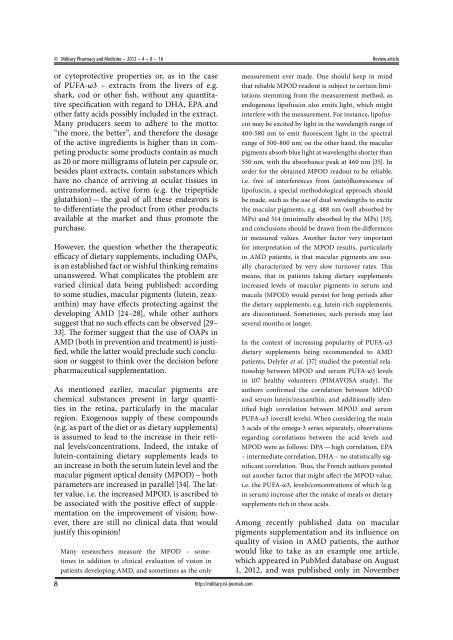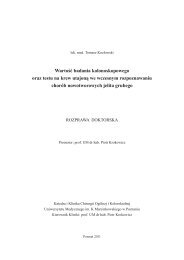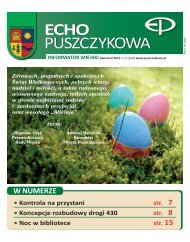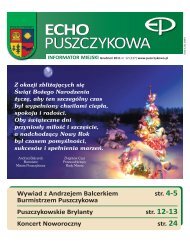MILITARY PHARMACY AND MEDICINE
MILITARY PHARMACY AND MEDICINE
MILITARY PHARMACY AND MEDICINE
You also want an ePaper? Increase the reach of your titles
YUMPU automatically turns print PDFs into web optimized ePapers that Google loves.
© Military Pharmacy and Medicine • 2012 • 4 • 8 – 16or cytoprotective properties or, as in the caseof PUFA-ω3 – extracts from the livers of e.g.shark, cod or other fish, without any quantitativespecification with regard to DHA, EPA andother fatty acids possibly included in the extract.Many producers seem to adhere to the motto:“the more, the better”, and therefore the dosageof the active ingredients is higher than in competingproducts: some products contain as muchas 20 or more milligrams of lutein per capsule or,besides plant extracts, contain substances whichhave no chance of arriving at ocular tissues inuntransformed, active form (e.g. the tripeptideglutathion) — the goal of all these endeavors isto differentiate the product from other productsavailable at the market and thus promote thepurchase.However, the question whether the therapeuticefficacy of dietary supplements, including OAPs,is an established fact or wishful thinking remainsunanswered. What complicates the problem arevaried clinical data being published: accordingto some studies, macular pigments (lutein, zeaxanthin)may have effects protecting against thedeveloping AMD [24–28], while other authorssuggest that no such effects can be observed [29–33]. The former suggest that the use of OAPs inAMD (both in prevention and treatment) is justified,while the latter would preclude such conclusionor suggest to think over the decision beforepharmaceutical supplementation.As mentioned earlier, macular pigments arechemical substances present in large quantitiesin the retina, particularly in the macularregion. Exogenous supply of these compounds(e.g. as part of the diet or as dietary supplements)is assumed to lead to the increase in their retinallevels/concentrations. Indeed, the intake oflutein-containing dietary supplements leads toan increase in both the serum lutein level and themacular pigment optical density (MPOD) – bothparameters are increased in parallel [34]. The lattervalue, i.e. the increased MPOD, is ascribed tobe associated with the positive effect of supplementationon the improvement of vision; however,there are still no clinical data that wouldjustify this opinion!Many researchers measure the MPOD – sometimesin addition to clinical evaluation of vision inpatients developing AMD, and sometimes as the onlyReview articlemeasurement ever made. One should keep in mindthat reliable MPOD readout is subject to certain limitationsstemming from the measurement method, asendogenous lipofuscin also emits light, which mightinterfere with the measurement. For instance, lipofuscinmay be excited by light in the wavelength range of400-580 nm to emit fluorescent light in the spectralrange of 500-800 nm; on the other hand, the macularpigments absorb blue light at wavelengths shorter than550 nm, with the absorbance peak at 460 nm [35]. Inorder for the obtained MPOD readout to be reliable,i.e. free of interferences from (auto)fluorescence oflipofuscin, a special methodological approach shouldbe made, such as the use of dual wavelengths to excitethe macular pigments, e.g. 488 nm (well absorbed byMPs) and 514 (minimally absorbed by the MPs) [33],and conclusions should be drawn from the differencesin measured values. Another factor very importantfor interpretation of the MPOD results, particularlyin AMD patients, is that macular pigments are usuallycharacterized by very slow turnover rates. Thismeans, that in patients taking dietary supplementsincreased levels of macular pigments in serum andmacula (MPOD) would persist for long periods afterthe dietary supplements, e.g. lutein-rich supplements,are discontinued. Sometimes, such periods may lastseveral months or longer.In the context of increasing popularity of PUFA-ω3dietary supplements being recommended to AMDpatients, Delyfer et al. [37] studied the potential relationshipbetween MPOD and serum PUFA-ω3 levelsin 107 healthy volunteers (PIMAVOSA study). Theauthors confirmed the correlation between MPODand serum lutein/zeaxanthin, and additionally identifiedhigh correlation between MPOD and serumPUFA-ω3 (overall levels). When considering the main3 acids of the omega-3 series separately, observationsregarding correlations between the acid levels andMPOD were as follows: DPA — high correlation, EPA– intermediate correlation, DHA – no statistically significantcorrelation. Thus, the French authors pointedout another factor that might affect the MPOD value,i.e. the PUFA-ω3, levels/concentrations of which (e.g.in serum) increase after the intake of meals or dietarysupplements rich in these acids.Among recently published data on macularpigments supplementation and its influence onquality of vision in AMD patients, the authorwould like to take as an example one article,which appeared in PubMed database on August1, 2012, and was published only in November8 http://military.isl-journals.com
















